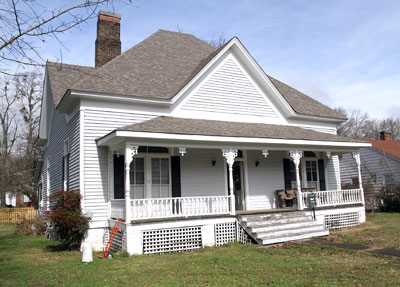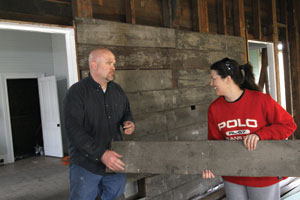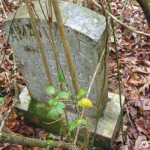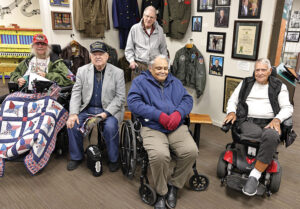
 New owners bring changes to historic Springville house
New owners bring changes to historic Springville house
Story by Tina Tidmore
Photos by Jerry Martin
A “For Sale” sign remained in the lawn of a 19th century Springville house for about six years. It has been known as the “Buchanan house” and the “Coupland-George house,” depending on who was living in it at the time. Due to a recent change in ownership, its future label may be the “Rayburn house.”
In January, Al and Lisa Rayburn purchased the light gray house that faces an empty lot next to Harrison Supply in Springville’s historic district. “I have always been a type that wanted new,” Lisa Rayburn said. “But it has so much character, like the hinges and doorknobs.”
The Rayburns searched six months for a new home while living in the tight quarters of a relative’s basement, a very different experience from the four-bedroom house they sold in July 2012. Over time, the list of required features for their next house became shorter because of their eagerness for more space.
Their desire to move grew from Al Rayburn reading Not a Fan: Becoming a Completely Committed Follower of Jesus, a book that contrasts being Jesus’ follower to being Jesus’ fan. “It was very convicting,” Lisa Rayburn said. “We felt like we had put a lot of identity into our things.” She said they had even lost the desire to foster children and they let their foster parent certification expire.
So they put the big house with the pool up for sale in a depressed housing market and waited to see what happened.
When an offer quickly came in close to what they were asking, they decided God was leading them to leave a materialistic life for another purpose, particularly fostering children again. With fewer expenses, they could do more for others, said Lisa Rayburn, a Springville Middle School counselor.
The Buchanan house had always intrigued Rayburn, who at one time lived on Bruce Street in Springville. “This is the house that we would drive by and be curious as to who lives there,” Rayburn said. She was attracted to the thought of walking on the sidewalks to local stores.
The house charmed Rayburn with its historical features, including 15-foot-high ceilings. Some of the rooms do not have modern flip light switches. They have two push-buttons: one to turn it on and the other to turn it off. Some of the rooms still have one old-fashioned bare light bulb hanging down from the ceiling for illumination.
Rayburn envisioned replacing the attic with bedrooms and a bathroom for when the children — both her own and the foster children — come for visits. The rooms downstairs could be modified into a greeting-computer room, living room, dining room, master bedroom, kitchen and two bathrooms.
 After some figuring, the Rayburns determined that purchasing and renovating the old house were within their budget. Although, Rayburn said that along the way they have added some “while we’re at it” changes that have increased the cost.
After some figuring, the Rayburns determined that purchasing and renovating the old house were within their budget. Although, Rayburn said that along the way they have added some “while we’re at it” changes that have increased the cost.
The couple is doing much of the work themselves during the evenings and on the weekends. Al Rayburn is an occupational therapist at HealthSouth Lakeshore Rehabilitation Hospital, but he does have some construction experience from working on rental houses he owns. The rest of the work is being contracted, including the rewiring. They expect to be finished by the end of summer.
“We want this to be a home where people come and run around,” said Rayburn, “instead of full of antiques.” However, she said she can’t resist putting in a claw-foot bathtub.
House History Mystery
Investigating the historical mysteries of early 19th century Springville houses is like a newcomer traveling the two-lane roads of St. Clair County. Some roads lead to surprise discoveries; some roads lead to a dead end; and sometimes a long, windy road leads to the desired destination. Occasionally, following a road because it looks familiar leads to the wrong conclusion, and sometimes the chosen road leads to confusion.
From 1944 until January 2013, the George family owned the house. Recent owner Diane George Meade decided to move closer to her sister in Anniston and closer to her lake property. Although she grew up in Springville, she said she didn’t have anything to keep her there anymore.
While the George family owned the house, it experienced some damage from the well-known 1969 train derailment and resulting propane gas tank explosions in Springville. Meade said she remembers the windows were blown out in one room, and one of the chimneys was badly damaged. All external evidence of the second chimney disappeared when it was covered with a new roof.
Meade recalls being told her grandmother insisted on having the large extension on the back torn down and replaced with the smaller extension the house now has. She also said her grandfather put in the only bathroom soon after World War II.
A 1944 deed shows O.J. George, Meade’s grandfather, purchased the house from Leon “Lonnie” Vann Coupland’s heirs.
Along with his in-laws, Leon Coupland owned a dry goods store within two blocks of the Buchanan house. The book, Heritage of St. Clair County, Alabama, describes the Coupland family as “known for their civic leadership, faithful religious service and fair business dealings.”
Leon Coupland’s mother was Mary Josephine Buchanan Coupland, and his father was Confederate veteran James Douglas Coupland. The 1944 deed describes Leon Coupland as Mary Josephine Coupland’s sole heir.
Meade also possesses an 1889 deed showing Mary Josephine Coupland buying out her nieces’ and nephews’ interest in the Buchanan house and lot. Mary Coupland’s mother, Eliza M. Buchanan, died in 1898 at age 82, although the obituary says “she had been feeble for a while.”
The Springville Preservation Society estimates the date of the house as 1885. “I think before the 1880s, the people were living on the northern end, around Forman Street,” said Millicent Yeager, society vice president.
However, Mary Josephine Coupland and her husband, Springville’s James Douglas Coupland, are shown in the 1880 census as living with Eliza M. Buchanan in Springville. Also in the household is their 7-year-old son, Leon. The McClendons, Formans and Hodges are their neighbors.
Between 1872 and her death, deeds show Eliza M. Buchanan selling hundreds of acres in Springville and Caldwell in St. Clair County. In the Springville area, the buyers include C.F. McClendon in 1895; H.R. Hearon in 1885; John McClendon in 1884 and E. Carpenter in 1876. But the Buchanan and Coupland family kept the house.
Sandra Tucker, also of the Springville Preservation Society, has a photo that shows the Buchanan house with a man, a child on his lap and a woman standing behind them. In The Heritage of St. Clair County, Alabama, the now-deceased Charlotte Claypool Duckett dates that photo to 1874 and said the man is James Douglas Coupland, and the child is Leon Vann Coupland. Records show Leon was born in 1873 and is the last child the couple had. The child in the photo appears to be no more than 2 years old, which would date the photo to 1875 at the latest if the child is Leon.
Another possible explanation that seems to fit the architecture of the house at the time of the photo, the child’s clothing and apparent hair bow and the apparent ages of the man and woman in the photo is that the child on James Coupland’s lap is either his granddaughter, Esther, or granddaughter, Helen, Leon’s daughters. If so, that would date the photo to about 1902 at the earliest.
Robert Gamble, senior architectural historian at the Alabama Historical Commission, says the roof line, the chimney style, porch style and other features make him think the house is from the mid-1880s.
“In all honesty, I have a difficult time dating this house much if at all earlier than 1880 — and actually later — as it appears even in the old photo,” Gamble said. “Perhaps an old house was radically altered, but I could not see photographic evidence of it.”
Adding to the possibility that the house was altered, though, is that Springville’s James Douglas Coupland, who was living in Eliza M. Buchanan’s home in 1880, is listed as a carpenter in the censuses.
Meade thinks the house is older than even 1870. The 1889 deeds Meade has in her possession say the house is “known as the E.M. Buchanan house and lot and being the same owned and occupied by H.R. Buchanan at the time of his death…”
Eliza M. Buchanan’s husband, Howell R. Buchanan, died in 1869, according to a headstone marker now leaning against a wall in the former smokehouse on the property. That date for his death is confirmed through an 1869 deed showing him granting right of way to the railroad, yet Eliza M. Buchanan is in the 1870 census without him. This would mean the house dates back to at least 1869, and another deed shows Howell R. Buchanan selling property in Springville as far back as 1862.
The exact year of the Buchanan house construction remains a mystery. But the future is certain with the Rayburns renovating it to become a lively family home.


















